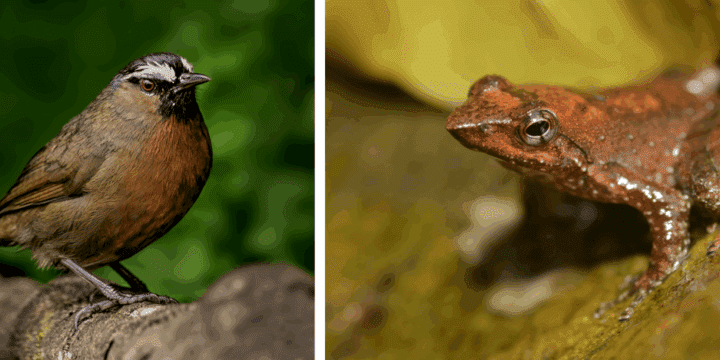Behaviour change for achieving the Kunming-Montreal Global Biodiversity Framework
This blog post was written by Molly Brown, PhD Student in the Leverhulme Centre for Anthropocene Biodiversity, University of York, UK, and previously a Project Coordinator for CASCADE, the Conservation and Sustainability Consortium of Academic Institutions.

When we think about biodiversity conservation, we often picture direct management of sites, ecosystems and species: releasing captive-bred tigers, hand-rearing cranes, planting trees, removing invasive species and so on. But there’s another powerful tool in the conservationist’s toolkit that often gets overlooked: behaviour change. By focusing on how people interact with the environment and how their behaviour affects it, we can make meaningful, lasting changes that benefit biodiversity. When carefully planned, tested and evaluated, behaviour change interventions can be extremely effective alongside other conservation strategies.
The role of behaviour change in conservation
Behaviour change is all about shifting how people act, and for conservation it is about behavioural changes that specifically support biodiversity. Sometimes, the change encouraged is as straightforward as encouraging people to eat less meat, recycle more, or use less plastic. Other times, it involves more intricate changes, such as how communities manage their natural resources, how businesses source their products, how governments enact policies to enable more sustainable choices, or how religious leaders sustainably integrate wildlife products into ceremonies. Either way, when groups of people and individuals adjust their actions and behaviours, it can have a profound positive impact on conservation efforts.

Evidence shows that behaviour change strategies are making a real difference. To produce a rapid review of behaviour change for biodiversity for the Convention on Biological Diversity COP16, I coordinated an interdisciplinary team of researchers to review over 75 case studies and identified several effective strategies for shifting behaviours. These approaches include educational campaigns, social marketing, financial incentives, and legal regulations. When applied thoughtfully, and often as part of a multipronged approach, these interventions can lead to sustainable practices that protect ecosystems and species over the long term. However, behaviour change is just one piece of the puzzle; it’s not a standalone solution. Rather, it’s an essential part of broader conservation efforts, working in tandem with other strategies.
Best practice stories
It’s one thing to talk about behaviour change in theory, but what does it look like in the real world? Here are a few examples where behaviour change interventions led to change:
Tanzania’s lion conflict: In Tanzania, a Maasai community faced the complex issue of lions attacking their livestock. As a result, retaliatory lion killings were on the rise. A behaviour change solution was introduced where financial rewards were given to the community based on how many lions survived. This financial incentive helped reduce the killings and fostered a more positive attitude towards lion coexistence.
Sustainable fishing in Southeast Asia: Fishing communities in countries like Indonesia and the Philippines struggle with overfishing. To address this, conservationists launched multiple campaigns that educated fishers on sustainable practices and created regulated “no-take” zones. By getting local fishers involved in the design and management of these areas, these initiatives saw effective results. More fish, healthier reefs, and higher compliance with the rules followed.

Wild meat consumption in Brazil: A campaign in Brazil encouraged locals to buy chicken instead of wild meat. The campaign used social marketing and financial incentives (chicken coupons), and together they led to an approximately 62% reduction in wild meat consumption in certain areas. Where only chicken coupons were provided, wild meat consumption did not change – showing the need for complementary strategies. This goes to show that even small shifts in behaviour can have a significant ripple effect when it comes to protecting wildlife.
Saiga antelope horn demand in Singapore: Consumer behaviour can be difficult to change, especially when it’s tied to deeply ingrained traditions. But in Singapore, a campaign aimed at reducing the use of saiga antelope horn as a traditional medicine tonic managed to do just that. Through an online strategy that amplified newspaper articles, the campaign raised awareness about the environmental cost of using saiga horn, leading to a drop in consumption.
These examples show that, while changing human behaviour can be challenging, it can lead to tangible results for conservation. Note also that some of these examples tracked the effects of interventions not only on human behaviour, but also through to the final biodiversity target. This is important, where possible, to demonstrate the behaviour change is having the desired ultimate effect.
Collaboration: the key to success
One of the most important things we learned from producing this rapid review evidence synthesis is the power of bringing different fields together. Conservation isn’t just about protecting wildlife; it’s also about understanding people. That’s why interdisciplinary collaboration is so important when it comes to understanding ways to change behaviour and how to design effective behaviour change strategies. We can look to the IUCN Behaviour Change Taskforce (part of the IUCN Commission for Species Survival and Commission on Education and Communication) for approaches to advancing collaboration for behaviour change.

Psychologists, economists, educators, and conservation social and ecological scientists all bring unique perspectives that help shape effective strategies. For example, behavioural science can give us insight into why people make the choices they do, while economics can help design and test incentives and educators can bring new value-based approaches to help us understand the world around us. And, perhaps most importantly, working with Indigenous Peoples and local communities ensures that interventions are culturally relevant and more likely to be embraced. It’s through the synthesis of knowledge and recognising the need for different strategies in different contexts that the most effective outcomes can be achieved.
Looking ahead
As the world grapples with escalating threats to biodiversity, behaviour change is emerging as a critical element in the conservation puzzle. While methods such as species, site and habitat management remain foundational, addressing the human dimensions of conservation issues allows us to develop more comprehensive solutions. In this way, we can tackle the root causes of the problem rather than merely addressing the symptoms, and thus achieve more meaningful and lasting conservation outcomes. It’s important that we share lessons from behaviour change interventions – including their effects on people and the target biodiversity – to inform the design of effective future conservation strategies. It’s also important to consider, and ideally monitor, unintended consequences of behaviour change interventions.
Conservation is no longer just about saving species or protecting land; it’s about understanding how human behaviour affects the natural world and finding ways to shift those behaviours for the better. Through interdisciplinary collaboration, we can design just, ethical and more effective strategies that benefit both people and the planet.

Read the full evidence synthesis report here: https://shiny.york.ac.uk/CASCADE-BEHAVIOUR-CHANGE/ or scan the QR code below. The report will be presented as part of a side event at the Convention on Biological Diversity COP16 in Cali, Colombia, on 23 October: https://www.cbd.int/side-events/6194




